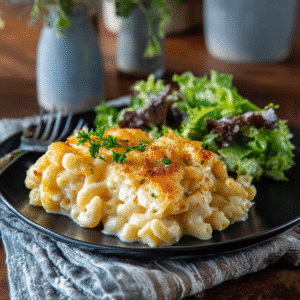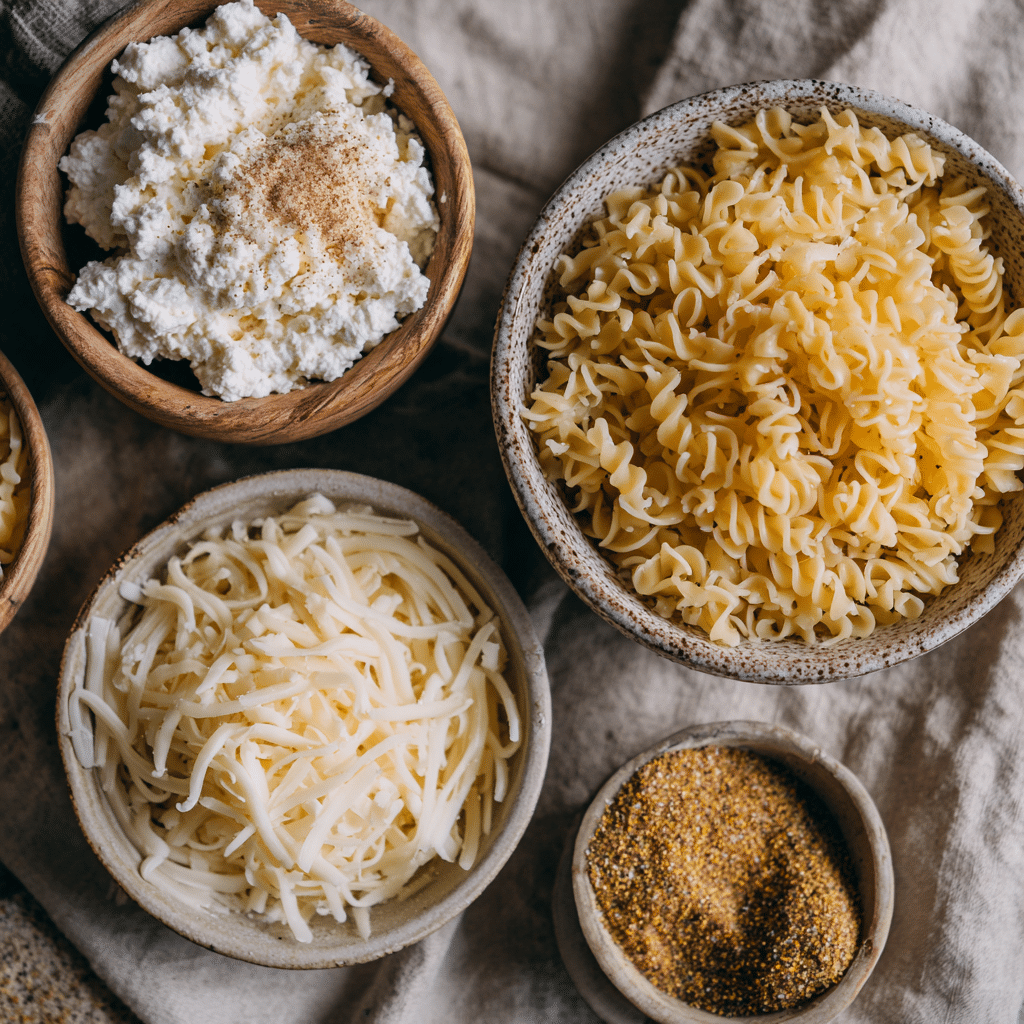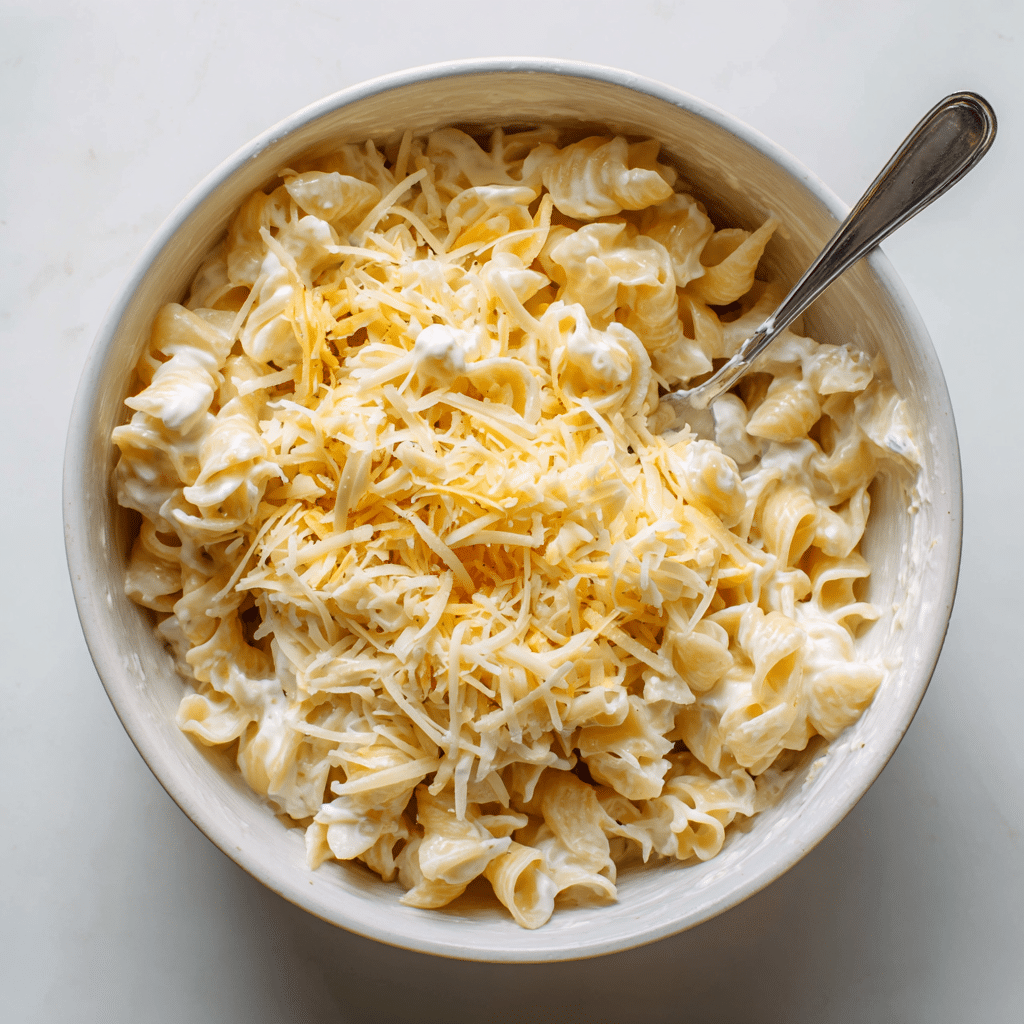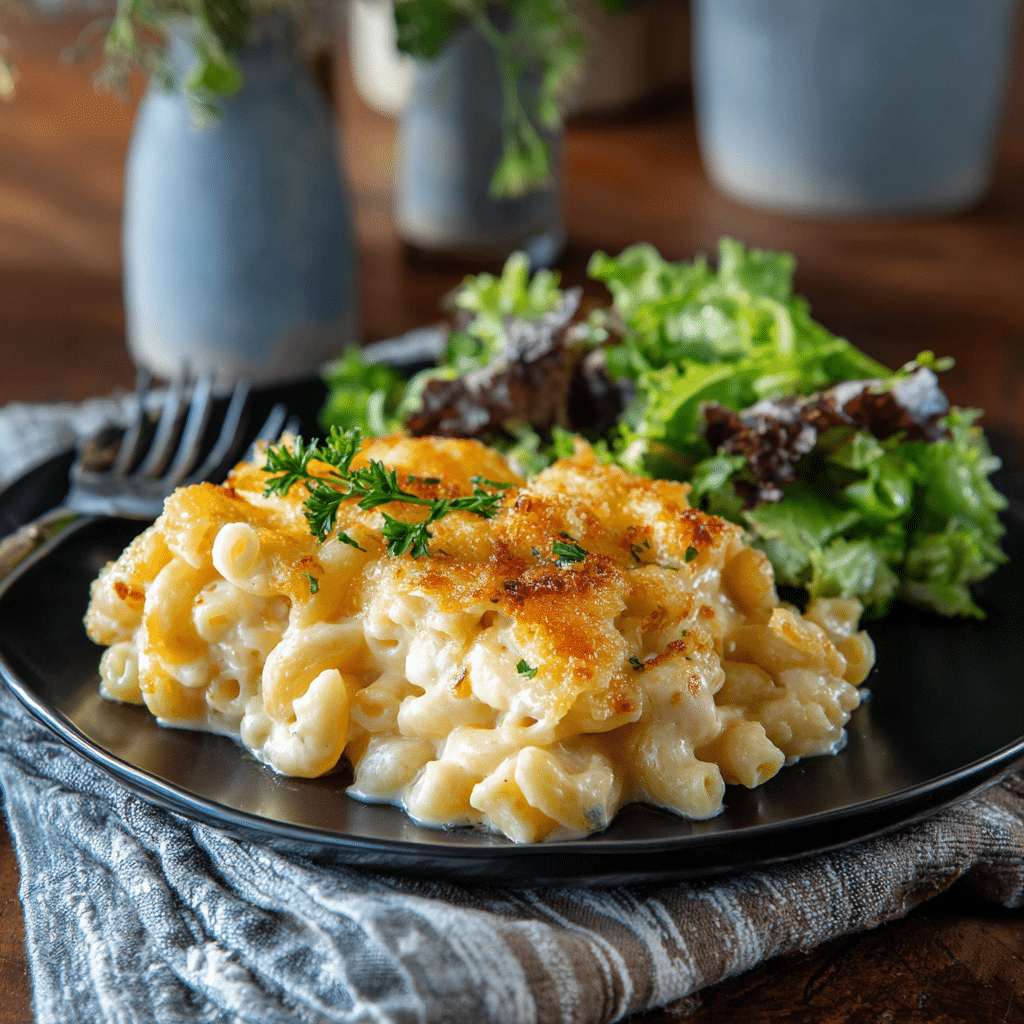Cottage mac and cheese gluten free is the ultimate nostalgic comfort food only now, it’s remade for sensitive bellies. In this article, you’ll discover what cottage cheese brings to mac and cheese, how it helps people ditch gluten without missing the creaminess, and step-by-step how to make it. We’ll also answer some common questions like whether cottage cheese really melts and what to substitute if it’s not your thing. Whether you’re gluten-intolerant or just curious about this protein-packed twist on a classic, you’re in for a delicious, wheat-free discovery.
Table of Contents
What it is: A Gluten Free Twist on a Classic
If you grew up loving mac and cheese, switching to gluten-free eating can feel like saying goodbye to an old friend. That’s exactly how I felt until I discovered cottage mac and cheese (gluten free). This version swaps out traditional flour-based béchamel for gluten-free pasta and creamy cottage cheese. The result? A dish that’s rich, slightly tangy, and deeply satisfying. It’s a healthier comfort food that doesn’t sacrifice flavor or texture.
Unlike boxed versions or flour-heavy sauces, cottage cheese melts into the dish naturally, creating a creamy, protein rich base. It’s perfect for gluten free comfort food lovers. If you already enjoy dishes like cottage cheese bread or cottage cheese chocolate mousse, you’ll appreciate how easily this ingredient adapts to savory meals too.

Cottage Mac and Cheese (Gluten Free)
Ingredients
- 8 oz gluten-free elbow pasta or preferred shape
- 1 cup cottage cheese whole milk or low-fat
- 1 cup shredded cheddar cheese
- 1/2 cup shredded mozzarella cheese
- 1/2 tsp garlic powder
- 1/2 tsp onion powder
- Salt and pepper to taste
- Optional: 1 tsp mustard powder or 1 tbsp nutritional yeast
- Optional: Splash of milk or water to thin sauce
Instructions
- Preheat oven to 375°F if baking.
- Cook gluten-free pasta until al dente, then drain and set aside.
- In a blender, combine cottage cheese, garlic powder, onion powder, salt, pepper, and a splash of milk or water. Blend until smooth.
- In a pot, combine cooked pasta with blended cottage cheese sauce.
- Stir in cheddar and mozzarella cheese until melted and creamy.
- For baked version: transfer to baking dish, top with extra cheese, and bake 20 minutes until bubbly and golden.
- Serve warm. Stores well and reheats beautifully.
Notes
Nutrition
Who it’s helped: From Fatigue to Flourless Joy
As a Tuscan chef trained in traditional cuisine, my journey to creating cottage mac and cheese (gluten free) started with necessity. Years of unexplained fatigue led me to a gluten-free diagnosis and to the realization that I’d have to reinvent many of my favorite recipes. This mac and cheese became one of the first dishes where I found new joy without wheat. It kept my traditions alive in a nourishing, energizing way.
Families, athletes, and gluten free eaters have shared how this dish fits their needs. It’s quick, high in protein, and never feels like a compromise. Pair it with soft homemade gluten-free bread or follow it with gluten-free banana bread either way, you’re in for pure comfort.
How it works: Why Cottage Cheese Makes Sense in Mac and Cheese
Cottage cheese might seem like an odd choice at first, but it works beautifully in cottage mac and cheese (gluten free). When blended or baked, cottage cheese turns silky smooth, offering that creamy texture we expect from classic mac and cheese. It’s naturally high in protein and low in fat, making it a smart base for a healthier sauce. Plus, it eliminates the need for flour-based roux or heavy cream, both of which are common gluten traps.
For those wondering, yes cottage cheese melts, especially when it’s pureed or folded into warm pasta. When combined with a little shredded cheddar or mozzarella, it gives you that gooey, rich bite everyone loves. It holds up beautifully in baked versions, too, making it ideal for meal prep or potlucks. And unlike many gluten-free cream sauces, this one doesn’t separate or turn grainy.
You can even use it in other high protein meals like these cottage cheese pancakes for a similar creamy consistency without gluten.

What it’s made of: Simple, Smart, Gluten Free Ingredients
The ingredient list for cottage mac and cheese (gluten free) is short but powerful. You’ll need:
- Gluten-free elbow pasta (or your favorite shape)
- Cottage cheese (whole milk or low fat both work)
- Shredded cheddar or mozzarella (for stretch and flavor)
- Garlic powder, onion powder, salt, and pepper (to enhance taste)
- Optional: nutritional yeast or mustard powder for tang
Everything blends together in one pot or a single baking dish. There’s no need for complicated sauces or long cooking steps. The result is cozy, filling, and surprisingly nourishing.
It also pairs well with a side like gluten-free chicken tenders or a slice of gluten-free blueberry coffee cake for dessert.

What it’s made of: Nutrients You Can Feel Good About
One reason cottage mac and cheese (gluten free) is such a satisfying meal is that every ingredient plays a role in both taste and nutrition. Cottage cheese is the heart of the dish, packed with slow-digesting protein, calcium, and gut-friendly probiotics. It adds that signature creaminess without needing butter or flour.
Paired with a high quality gluten free pasta like one made from brown rice, quinoa, or lentils you get a strong foundation of fiber and energy. Add sharp cheddar for bite, a little mozzarella for melt, and seasonings like garlic powder, onion powder, and a dash of mustard powder or nutritional yeast for depth.
There’s no hidden starch or filler just real, nourishing food. Serve it up with gluten-free zucchini bread or alongside gluten-free chicken tenders for a well rounded, comfort forward meal.
How to make it: Quick, Easy, No Fuss
Making cottage mac and cheese (gluten free) takes less than 30 minutes, start to finish. First, boil your gluten free pasta until al dente, then drain. While it cooks, blend your sauce: cottage cheese, a splash of milk or water, garlic powder, onion powder, salt, and pepper until smooth.
Pour the sauce over the hot pasta and stir in shredded cheese. If you want a baked version, spread it in a baking dish, top with more cheese, and bake at 375°F for 20 minutes.
That’s it no roux, no gluten, no guesswork. It reheats well, stores beautifully, and tastes even better the next day. With a side of fresh greens or a slice of gluten-free blueberry coffee cake, this dish goes from comfort food to everyday staple.

Conclusion
Cottage mac and cheese (gluten free) isn’t just a clever workaround it’s a comfort food reimagined with purpose. From the creamy, protein rich sauce to the short, wholesome ingredient list, it’s a dish that works for weeknights, meal prep, and special occasions alike. Whether you’re avoiding gluten for health or lifestyle reasons, this recipe proves you don’t have to sacrifice flavor or satisfaction. Try it once, and it might just become your go-to mac.
Can you use cottage cheese for mac and cheese?
Yes, and it works better than you might expect. Cottage cheese blends into a creamy sauce that coats the pasta beautifully, especially when combined with a little shredded cheddar or mozzarella. It’s naturally high in protein, making it ideal for those looking for a more balanced comfort food. For anyone exploring gluten-free alternatives, this is where cottage mac and cheese (gluten free) really shines it’s nutritious, rich, and satisfying.
Why is cottage cheese not always gluten free?
Plain cottage cheese is generally gluten-free. The problem arises with flavored or low fat varieties that may include stabilizers or thickeners derived from wheat. That’s why it’s important to read labels or stick with certified gluten free brands when preparing a recipe like cottage mac and cheese (gluten free). Clean, simple ingredients always make a difference.
What to use instead of cottage cheese in mac and cheese?
If cottage cheese isn’t your favorite, other soft, high protein options like ricotta or even thick Greek yogurt can be good alternatives. They provide a similar creamy texture, though the flavor will change slightly. Vegan alternatives, such as cashew cream, can work too. This flexibility makes the dish adaptable and still delicious even if you tweak it.
Does cottage cheese melt?
Not in the same way cheddar melts, but yes it breaks down when heated or blended. This makes it perfect for smooth, sauce based recipes. Once it’s mixed with other melty cheeses and heated, cottage cheese becomes part of a rich, creamy texture that rivals any traditional sauce. You won’t end up with lumps just velvety, savory goodness.
Can cottage cheese replace milk in mac and cheese?
Definitely. Blended cottage cheese can replace milk entirely in many recipes, including gluten free mac and cheese. Just thin it slightly with water or non dairy milk to achieve the right pourable consistency. It brings a protein rich, creamy texture that holds up well, especially when baked.

